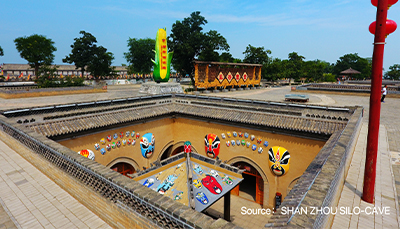



Source:<http://www.szdky.cn/index.aspx>
Introduction
On August 25th, 2023, the cultural section of People’s Daily published the article “Reviving the Vitality of Rural Architecture”, written by Wang Fang, Professor at Peking University.
Author: Wang Fang, Secretary General of UPSC, Basin Spatial Planning Branch, Secondary Professor at Peking University, Yangtze River Scholar Distinguished Professor appointed by the Ministry of Education.
"Entering villages without seeing houses, hearing voices without seeing people." Silo-cave is a typical sunken rural architecture, utilizing underground spaces to create a warm environment in winter and a cool one in summer. As a once-habitable architecture in the Loess Plateau region in the Yellow River basin, silo-cave reflects a series of typical lifestyles within its specific historical and environmental context.There are numerous silo-caves in Shanzhou District of Sanmenxia, Henan, which are the most typical and representative ones among all. In modern society, it’s a hot topic to fully develop its construction wisdom and rural memories behind it, and to optimize its building performances to fit into modern lifestyles.
The natural ecology environment of the Loess Plateau region is fragile and sensitive. The silo-caves reflect the residential wisdom of the ancient Chinese ancestors to adapt to this environment in the process of its formation and development. The building technics of the silo-cave is listed in the third batch of National Intangible Heritage Cultural List. The Miaoshang Village in Xizhangcun Town, Shanzhou District, is listed in the first batch of Chinese Traditional Villages Directory, and the silo-cave in Miaoshang Village is listed in the seventh batch of the National Key Cultural Relics Protection Units List.
The Peking University team has been doing field research on silo-caves in recent years, focusing on the inheritance of cultural heritage value and sustainable development in urban and rural areas. The research reveals that over the past 20 years, more than two-thirds of the villagers in the Qu Village in Shanzhou District has relocated to overground buildings from the silo-caves. Despite the availability of repair subsidies, more people prefer moving to the overground buildings for a more convenient lifestyle. Elder people are usually the ones who are still living in the silo-caves, because they are very used to this lifestyle they have been living for decades. However, the silo-caves have been collapsed and discarded in this process. It is an urgent issue to redevelop the sense of belonging and identity of the residents.
It is worth noticing that the silo-cave offers a unique and distinctive experience of human landscape. People’s attention has been expanded from architecture units to social, economic, and cultural aspects, discovering its development from a comprehensive perspective in recent years. For example, in Qu Village in Shanzhou District, the government has allocated special funds to improve silo-caves and its surroundings, and encourage the village committees and local tourism associations to lead the revitalization of the silo-caves. We are happy to see that, with the improvement of infrastructural facilities and the spreading reputation of the silo-caves, more villagers who used to work in other places chose to return to their hometown. With the help of the government, they started their own business by renovating the silo-caves and running local homestays. The villagers told us that, without the construction of the water pipes, people would have to lift the sanitary sewage above the ground manually as before. This alone would prevent them from returning home.
Silo-cave, as one of the most distinctive rural architectures in traditional residences, witnesses the long-term coadaptation between human and water in the Yellow River basin, and represents the splendidness of the cultural heritage in Chinese history and civilization. From the perspective of human-nature co-living and from the eye of the people living in this area, we should learn the humanity value and the living demand of this human settlement and the rural architectures on the watershed region, to protect and fully utilize the valuable cultural heritage of the watershed.
Source: <https://mp.weixin.qq.com/s/F-QX7AvAe0xbbAC75QC-bQ>
Photo provided by SHAN ZHOU SILO-CAVE <http://www.szdky.cn/index.aspx>
Translated by He Huiling